Plankton
Type of resources
Available actions
Topics
Keywords
Contact for the resource
Provided by
Formats
Representation types
Update frequencies
status
-
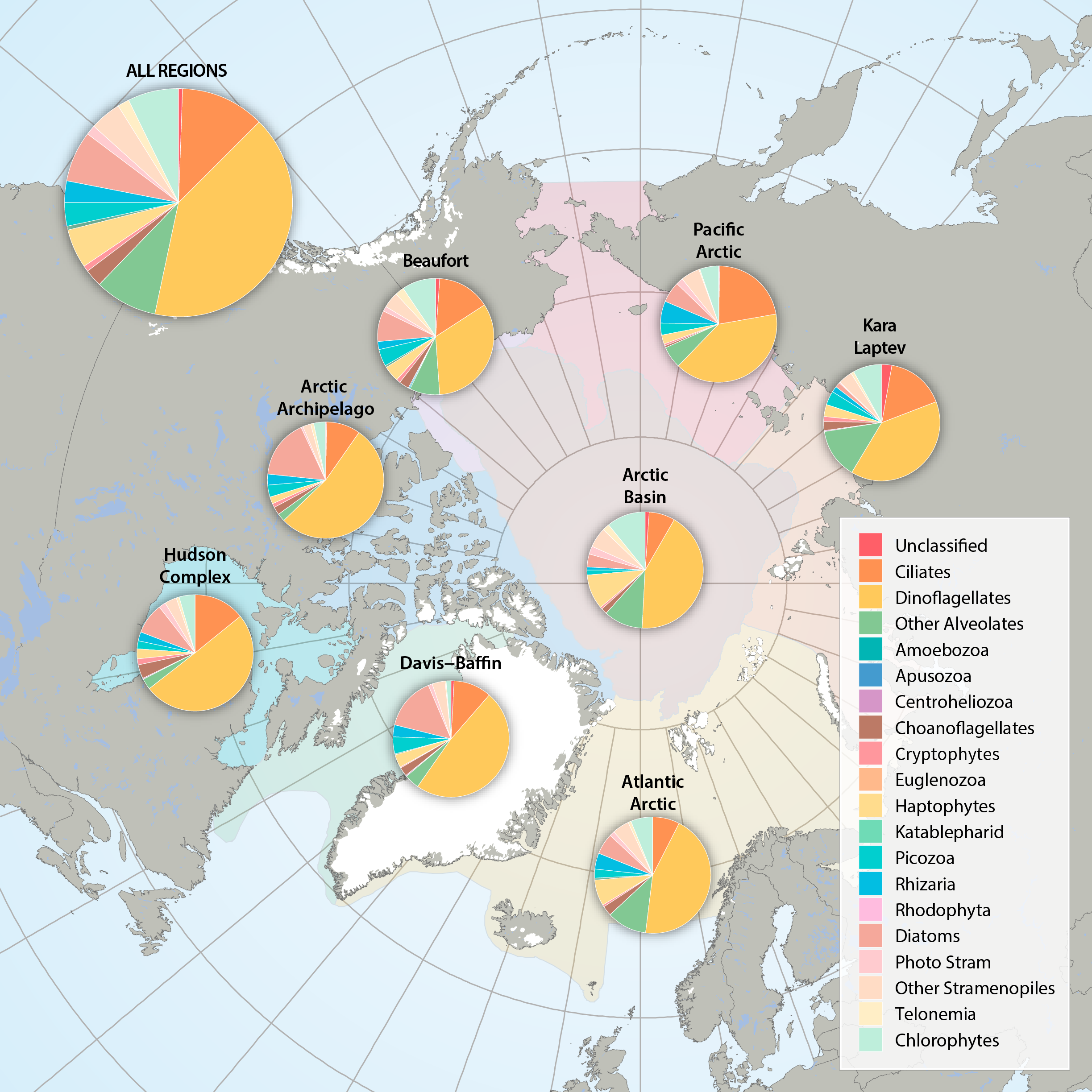
Figure 3.2.2a: Relative abundance of major eukaryote taxonomic groups found by high throughput sequencing of the small-subunit (18S) rRNA gene across Arctic Marine Areas. Figure 3.2.2b: Relative abundance of major eukaryote functional groups found by microscopy in the Arctic Marine Areas. STATE OF THE ARCTIC MARINE BIODIVERSITY REPORT - <a href="https://arcticbiodiversity.is/findings/plankton" target="_blank">Chapter 3</a> - Page 70 - Figures 3.2.2a and 3.2.2b
-
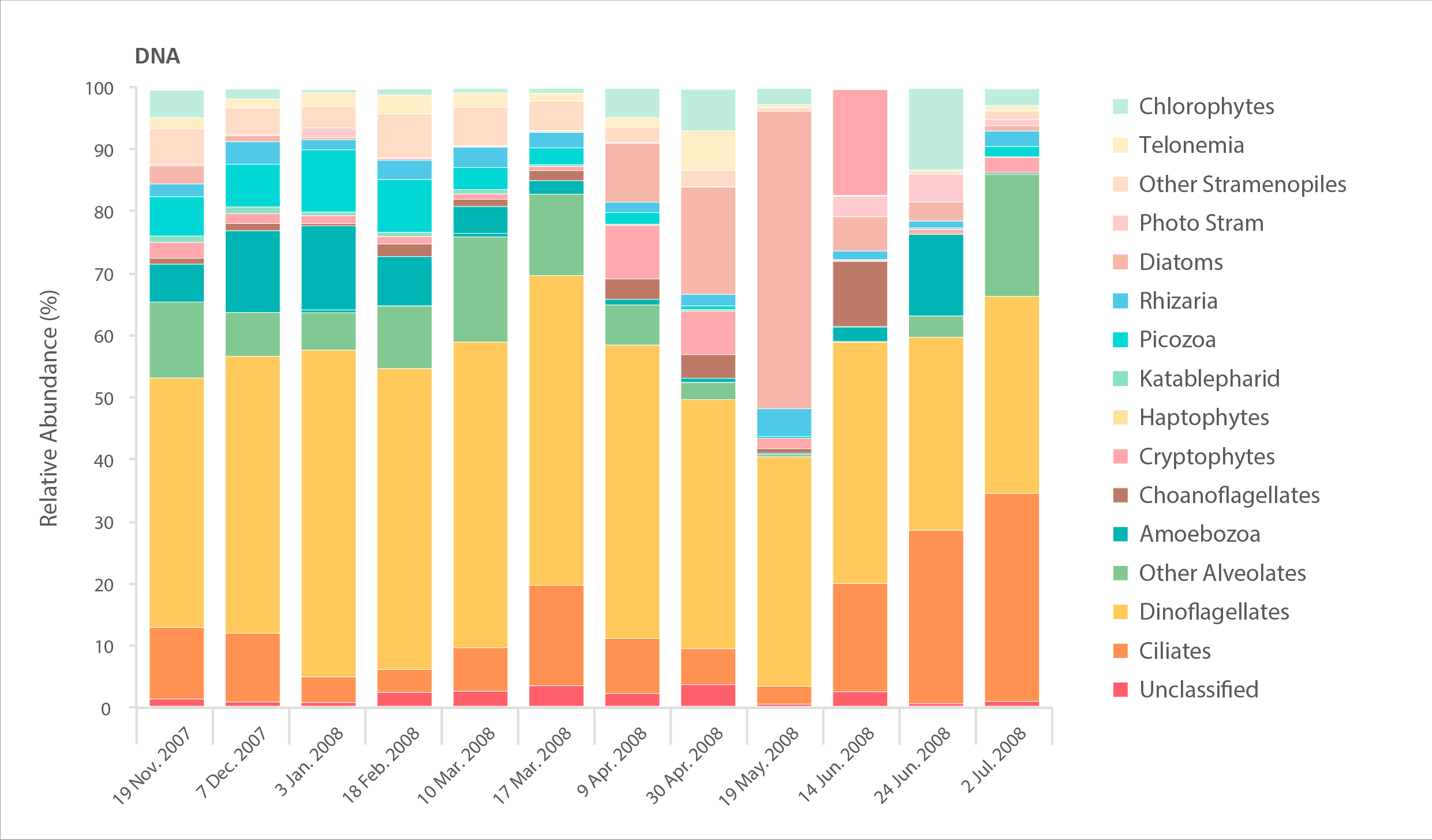
Relative abundance of major eukaryote taxonomic groups found by high throughput sequencing of the small-subunit (18S) rRNA gene. Time series collected by sampling every 2-6 weeks in Amundsen Gulf of the Beaufort Sea over the winter-spring transition in 2007–2008. Sampling DNA gives information about presence/absence, while sampling RNA gives information about the state of activity of different taxa. STATE OF THE ARCTIC MARINE BIODIVERSITY REPORT - <a href="https://arcticbiodiversity.is/findings/plankton" target="_blank">Chapter 3</a> - Page 72 - Figures 3.2.3
-
Plankton (zooplankton and large phytoplankton) are collected using the Continuous Plankton Recorder (CPR) in the Northwest (NW) Atlantic along tracks transited by container ships from Reykjavik (Iceland) to St. John’s, NL (the Z line), and between St. John’s and the New England Coast, along the Scotian Shelf (the E and MD lines). The CPR Survey is the longest running, most geographically extensive marine ecological survey in the world, providing comparable data on the geographical distribution, seasonal cycles and year-to-year changes in abundance of plankton over a large spatial area. The first northwest Atlantic samples were collected in the Irminger Sea in 1957, and sampling was extended farther west to the Scotian Shelf a few years later. Sampling has continued to the present with some interruptions during the late 1970s and 1980s. Sampling is nominally once per month along the E, MD, and Z lines. DFO Sample collection and analysis are led by the Continuous Plankton Recorder Survey program at the Marine Biological Association of the UK. DFO provides partial support for the northwest Atlantic survey carried out on the E, MD, and Z lines and incorporates CPR data in Atlantic Zone Monitoring Program ocean environmental status reporting.
-
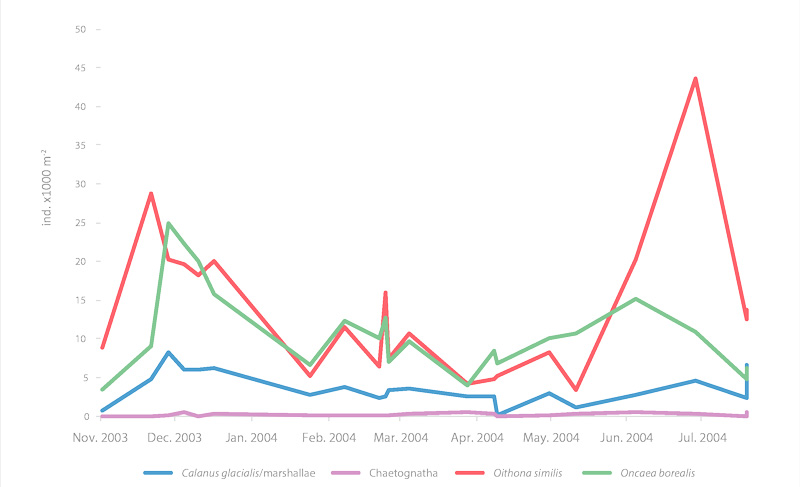
Seasonal time series of the major zooplankton in Franklin Bay, Canada STATE OF THE ARCTIC MARINE BIODIVERSITY REPORT - <a href="https://arcticbiodiversity.is/findings/plankton" target="_blank">Chapter 3</a> - Page 78 - Figure 3.2.9 Mesozooplankton abundance, integrated from 10 m above the seafloor to the surface (ind m-2), in Franklin Bay during the CASES 2003-04 overwintering expedition. Most of the sampling was done at the overwintering station and a few stations were close to this site in autumn 2003 and summer 2004.
-
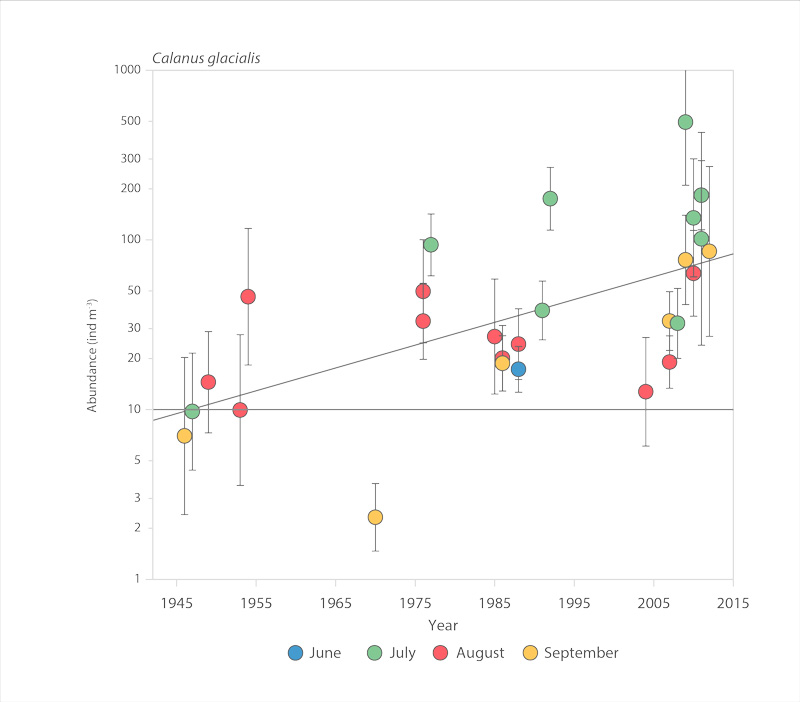
Abundance of the copepod Calanus glacialis in the Chukchi Sea, 1945-2012 (after Ershova et al. 2015b). STATE OF THE ARCTIC MARINE BIODIVERSITY REPORT - <a href="https://arcticbiodiversity.is/findings/plankton" target="_blank">Chapter 3</a> - Page 75 - Figure 3.2.6
-
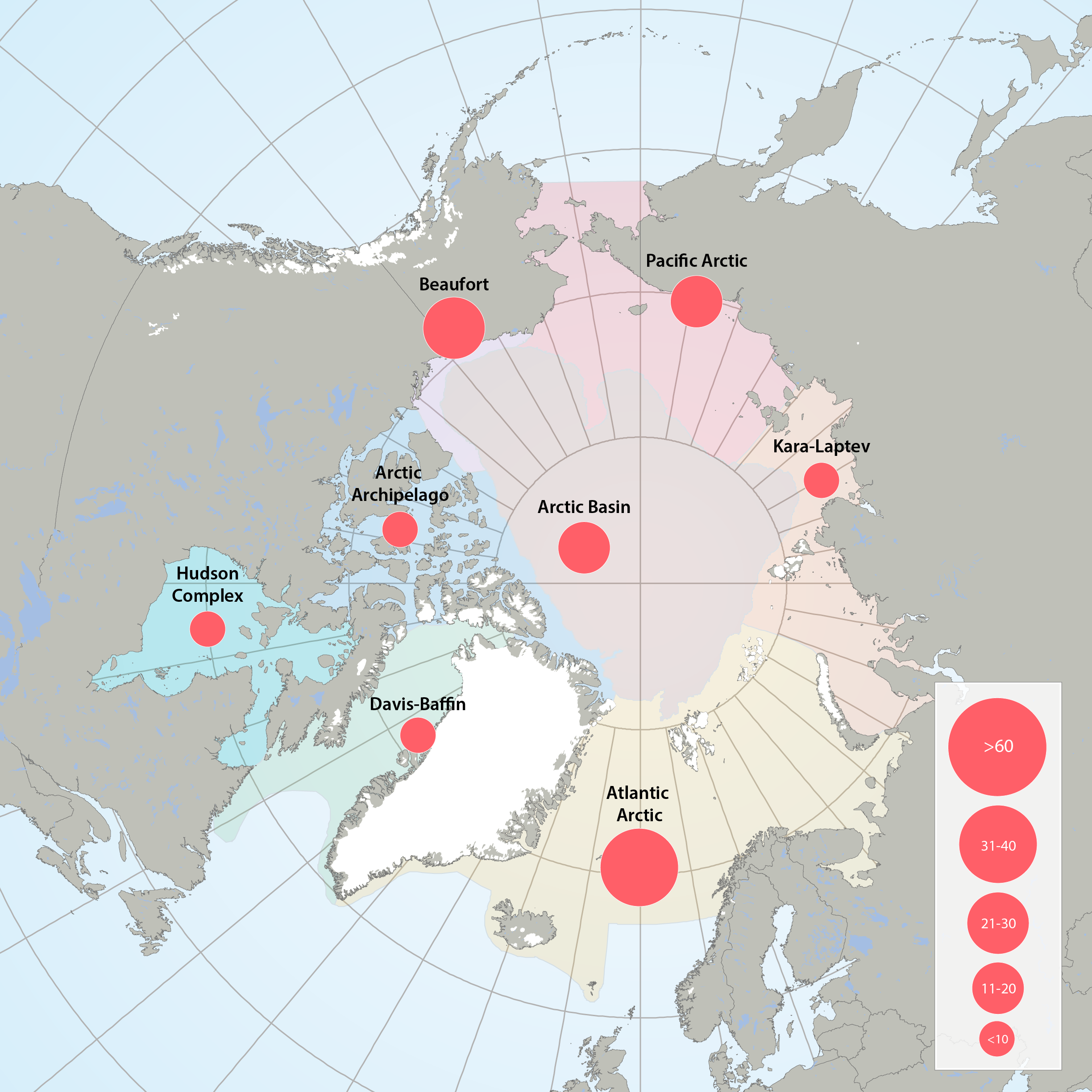
Figure 3.2.1a: Map of high throughput sequencing records from the Arctic Marine Areas. Figure 3.2.1b: Map of records of phytoplankton taxa using microscopy from the Arctic Marine Areas. STATE OF THE ARCTIC MARINE BIODIVERSITY REPORT - <a href="https://arcticbiodiversity.is/findings/plankton" target="_blank">Chapter 3</a> - Page 35 - Figure 3.2.1a and Figure 3.2.1b In terms of stations sampled, the greatest sampling effort of high-throughput sequencing in Arctic marine water columns, by far, has been in the Beaufort Sea/Amundsen Gulf region and around Svalbard. High through-put sequencing has also been used on samples from the Chukchi Sea, Canadian Arctic Archipelago, Baffin Bay, Hudson Bay, the Greenland Sea and Laptev Sea.
-
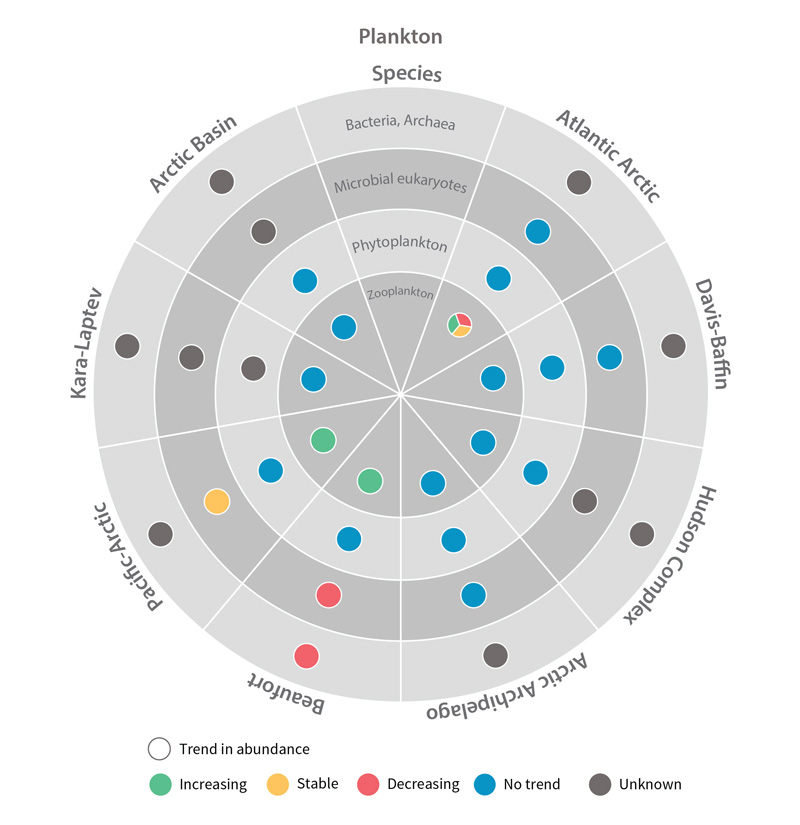
Trends in abundance of plankton Focal Ecosystem Components across each Arctic Marine Area. STATE OF THE ARCTIC MARINE BIODIVERSITY REPORT - Chapter 4 - Page 178 - Figure 4.2
-

Phytoplankton pigments, determined by high-performance liquid chromatography (HPLC) are measured on DFO cruises three times a year in February, June, and August/September along Line P in the northeast subarctic Pacific. Sampling for phytoplankton pigments started in 2006 at the five main Line P stations and was expanded to sample at all twenty seven stations along the transect in June 2010.
-

Phytoplankton pigments, determined by high-performance liquid chromatography (HPLC) have been measured on DFO La Perouse cruises since 2011. Surface samples are taken along a series of transects off the west coast of Vancouver Island twice a year usually in May/June and early September.
-

Ocean physical conditions in the Maritimes Region in 2019 were characterized by cooler surface temperatures, continued warmer bottom temperatures and weaker stratification compared to recent years. Deep nutrient inventories were lower than normal over most of the region, with the exception of the Cabot Strait section where deep nutrients were near or higher than normal during the spring sampling and associated with record-warm water. Anomalies of surface nutrients were negative across the region, with the exception of positive anomalies observed at the deep shelf and offshore stations of the Louisbourg section. The spring phytoplankton bloom was near or slightly earlier than normal across the Scotian Shelf (SS) with near-normal duration. Peak chlorophyll a concentrations during the spring bloom occurred within a narrow time window across the SS. At Halifax-2 (HL2), the spring bloom was characterized by a high amplitude, and a rapid progression and decline. Plankton community changes persisted in 2019 with lower abundance of large phytoplankton (diatoms), mainly lower-than-normal biomass of zooplankton and abundance of Calanus finmarchicus, and higher-than-normal abundance of non-copepods. Arctic Calanus and warm-shelf copepods showed mixed abundance anomalies in 2019, reversing the pattern of 2018. Above-normal abundances of Oithona atlantica, especially at HL2, suggest a greater influence of offshore waters in recent years. Surface temperature in the Bedford Basin was near normal in 2019 with mainly cooler-than-normal temperatures from January to June and near- or slightly-above-normal temperatures from July to December. Bottom temperature and salinity were below normal in 2019 with near- or slightly-above-normal conditions at the start of the year and progressing toward cooler and fresher water from February to December. Surface and deep nitrate, phosphate and silicate were near or below normal, with surface phosphate reaching a record low in 2019. The 2018 Continuous Plankton Recorder data indicated an annual abundance of diatoms close to normal for the Eastern (ESS) and Western Scotian Shelf (WSS), while the abundance of dinoflagellates and the Phytoplankton Colour Index values were near (WSS) or above (ESS) normal. The annual abundance of Calanus CI-IV was near normal (ESS) or slightly below normal (WSS), while C. finmarchicus CV-VI levels were slightly below (ESS) or below (WSS) normal. The abundance of Calanus glacialis (ESS, WSS) and Para/Pseudocalanus and Limacina spp. (WSS) were lower than normal, while that of coccolithphore (ESS, WSS), and copepod nauplii and foraminifera (ESS) was higher than normal. "
 Arctic SDI catalogue
Arctic SDI catalogue